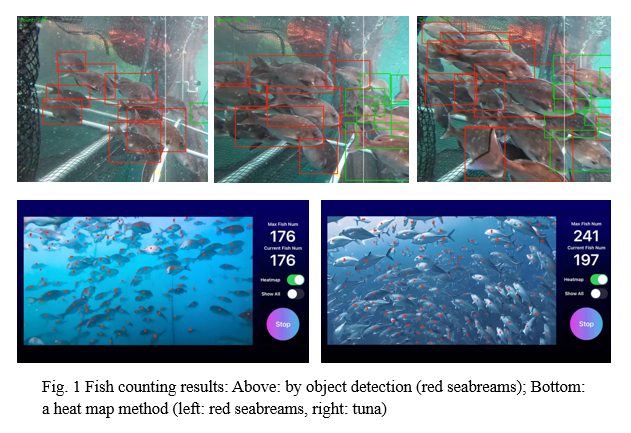ON-DEVICE AI-ENHANCED REAL-TIME FISH COUNTING SYSTEM IN AQUACULTURE
Introduction
Aquaculture is a crucial industry in global food production, facing numerous challenges in efficiency, cost management, and environmental impact. Traditional methods of monitoring aquaculture rely on manual labor and primitive technologies, leading to inefficiencies and high operational costs. To address these challenges, this research focuses on developing an AI-empowered system capable of real-time fish counting underwater using on-device technology. By deploying advanced neural network models on edge devices, we aim to revolutionize aquaculture monitoring.
Methods
Accurate fish counting is essential for optimizing feeding strategies, which not only benefits fish farmers economically but also helps prevent marine pollution from excess feed. Key fish counting events include transferring juveniles into cages, monitoring growth phases in the cages, and during harvest. We have adopted different counting methodologies for each scenario: 1.Object Detection: Fish are often moved through specific checkpoints, making object detection suitable for counting during transfers. Correct camera positioning is crucial for this method. 2. Heat Map: In densely populated environments like entire cages, occlusion presents challenges for object detection; thus, a heat map approach is more appropriate.
We utilized a large-scale dataset consisting of videos collected on-site and synthetic videos generated via 3D CG simulations for training. The 3D CG generated data is especially valuable as it can be treated as ground truth. These datasets cover diverse environmental conditions, including varying lighting, water quality, and fish species. For the m odel training, we employed advanced deep learning techniques, we trained neural networks to achieve high precision and efficiency. For the e dge deployment, the model is deployed onto chipsets near underwater cameras, enabling real-time processing and eliminating the need to transmit large volumes of video data.
Implementation
The system is designed to maximize efficiency and adaptability.Utilizing high-performance embedded chipsets like the Snapdragon 8 Gen 3 processor enables real-time video processing in embedded systems.Underwater cameras collect video data, which is processed locally on the embedded system. This reduces latency and communication overhead. Our application includes specialized neural network models for fish countings , and these models are all optimized for edge computing. Only essential metadata and summaries are sent to the central monitoring system, ensuring bandwidth efficiency.
Results and Discussion
We conducted fish counts during transfers and within entire cages. The deep learning models achieved 90%-95% accuracy in real-time underwater environments. However, for entire cage counts, visibility of the whole cage is crucial. Counting during transfers proved faster and less stressful for the fish compared to current mechanical systems. The on-device processing capabilities eliminated the need for extensive data transmission infrastructure, increasing system reliability and reducing overall costs.
These findings contribute to the following expectations. Real-time measurement of fish numbers and appetite indicators reduces feed waste and lowers production costs, enhancing feeding efficiency. Automated fish counting and size estimation during transfers increase process efficiency and operational productivity.
Future research will focus on several key areas. Enhancements to neural network models will continue to accommodate a broader range of environmental conditions and fish species. The system’s scalability will be ensured for deployment in large, diverse aquaculture environments. Predictive analytics will be integrated to provide early warnings for potential issues like disease outbreaks and environmental risks. Intuitive user interfaces will be developed for easier adoption and operation by aquaculture farm operators.
Conclusion
This research signifies a substantial advancement in aquaculture technology, providing a robust and efficient solution for farm monitoring. By leveraging advanced AI and edge computing, the study enhances operational efficiency, reduces costs, and improves the overall quality and safety of aquaculture practices. Anticipated future enhancements and expansions will further solidify this system as an indispensable tool in modern aquaculture.
